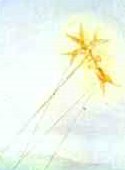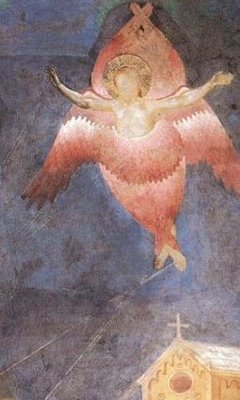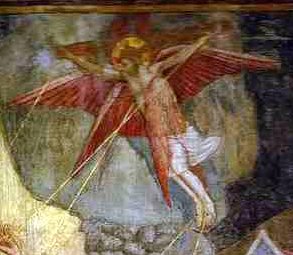Jesus kites
Schiller wrote about the 'naïve' and 'sentimental' appreciations of art: the former content just to let the work wash over him, the latter demanding an intellectual engagement. Mr. Miller, we trust, will not be offended by the modern negative connotations of the word naïve, here used in its Romantic sense, to accept an attribution of this label to his sensibilities. For what it's worth, Schiller associates the naïve with the natural man, to whom painting is more suited, and the sentimental with the cultured man, for whom literature is the chosen art-form. The cultured man, unlike the natural, 'has lost the harmony of his senses and is only striving for unity'. Poor us!

So I'm more of a sentimentalist. But I can cater to the naïve, too. This post is, like, totally naïve. So naïve that it can discuss 'Jesus kites' without recourse to abstruse interpretations. If Mr. Miller enjoys, as I do, the Osservanza Master, he will doutbless enjoy these Jesus kites too.

There is, I think, something touching—even sentimental, in the modern sense—about these holy kites, almost a religious experience, if I might be allowed to deviate from this site's mandate.

The Jesus kite (aquilone di Gesù) was an iconographical representation of Christ being flown as a kite: an eccentric subgenre of religious painting from the late Middle Ages through the early Italian Renaissance. Leonardo, late as he was, even produced a tentative 'Jesus helicopter', though I couldn't find an image online. The Jesus kites shown here are largely from the 14th and 15th centuries, though one is mediaeval, and one the work of a 16th-century Flemish imitator.

The kite, like most of the world's great technology pre-1600, was probably invented in ancient China; but with the trade-route established after Marco Polo, kites imported from 'Cathay' became popular in late mediaeval Italy as toys for the rich.

It was natural, therefore, for painters of the early Renaissance to demonstrate to their wealthy patrons the sanctity of the kites favoured by their children, wives and courtiers. Passages were found in the Latin Fathers, tenuously interpreted to be comparing the blessed Christ to a kite in his playful innocence; and the Viscontis of the time must have delighted in the notion—quite blasphemous in its hubris—that their god was nothing but a plaything to them.

So, I have not attempted any laboured analysis or hunting after mysteries here; I have merely offered my readers an free and unfettered glimpse into the now-forgotten world of the Jesus kite. Perhaps Mr. Miller could renew the tradition, and sculpt such a kite for us. . .

So I'm more of a sentimentalist. But I can cater to the naïve, too. This post is, like, totally naïve. So naïve that it can discuss 'Jesus kites' without recourse to abstruse interpretations. If Mr. Miller enjoys, as I do, the Osservanza Master, he will doutbless enjoy these Jesus kites too.

There is, I think, something touching—even sentimental, in the modern sense—about these holy kites, almost a religious experience, if I might be allowed to deviate from this site's mandate.

The Jesus kite (aquilone di Gesù) was an iconographical representation of Christ being flown as a kite: an eccentric subgenre of religious painting from the late Middle Ages through the early Italian Renaissance. Leonardo, late as he was, even produced a tentative 'Jesus helicopter', though I couldn't find an image online. The Jesus kites shown here are largely from the 14th and 15th centuries, though one is mediaeval, and one the work of a 16th-century Flemish imitator.

The kite, like most of the world's great technology pre-1600, was probably invented in ancient China; but with the trade-route established after Marco Polo, kites imported from 'Cathay' became popular in late mediaeval Italy as toys for the rich.

It was natural, therefore, for painters of the early Renaissance to demonstrate to their wealthy patrons the sanctity of the kites favoured by their children, wives and courtiers. Passages were found in the Latin Fathers, tenuously interpreted to be comparing the blessed Christ to a kite in his playful innocence; and the Viscontis of the time must have delighted in the notion—quite blasphemous in its hubris—that their god was nothing but a plaything to them.

So, I have not attempted any laboured analysis or hunting after mysteries here; I have merely offered my readers an free and unfettered glimpse into the now-forgotten world of the Jesus kite. Perhaps Mr. Miller could renew the tradition, and sculpt such a kite for us. . .



3 comments:
June brings the trade winds to Bali -- a stready 20-25 knot blow off the spice islands. Balinese put it to good use by flying all sorts of kites: some are Baris warriors, some of the evil goddess rangda, some -- political slogans. I haven't seen a Jesus kite yet, but I will suggest it. Perhaps I can make it my art project for my next trip. :)
Mr. Miller does not mind being called a 'naive', 'natural' man -- indeed, he likes the idea so much, he may no longer qualify.
And while he is often "content just to let the work wash over him" -- the experience is hardly like stepping into a shower -- other than for the first time he ever took one.
(wasn't it wonderful to be a little kid ?)
Regarding sculptural 'Jesus kites' -- I think I have seen a suspended crucifix before -- from about that same period -- and I think, as in the paintings, the suspension contributes to a sense of ominous mystery (how does it stay up there ? --- and --- what if it falls!)
And yet again -- the pictorial details that you have chosen are very attractive.
There's a real sense of an active, divine presence in these paintings/sculptures --- as well as in the church history of those centuries -- with the recent arrival of new saints and monastic orders .
BTW - where has the term "aquilone di Gesù" been used before ? Is it a recent art historical term or does it date back to the time when those paintings were made ?
"Is it a recent art historical term or does it date back to the time when those paintings were made?"
I think it's original to the period, but I could be wrong.
Post a Comment